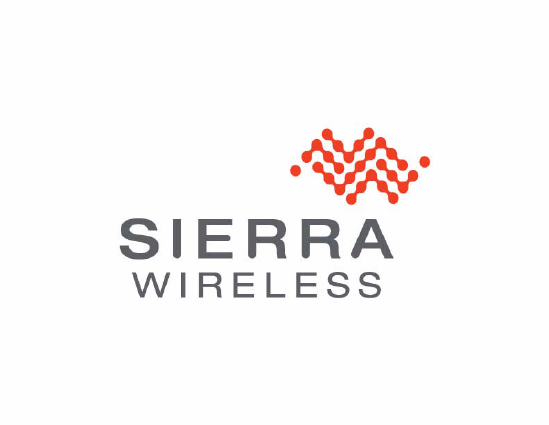Sierra Wireless MC7700 MC7700 Modem User Manual AirPrime MC7700 Hardware Integration Guide
Sierra Wireless Inc. MC7700 Modem AirPrime MC7700 Hardware Integration Guide
Contents
Hdw Integration Manual
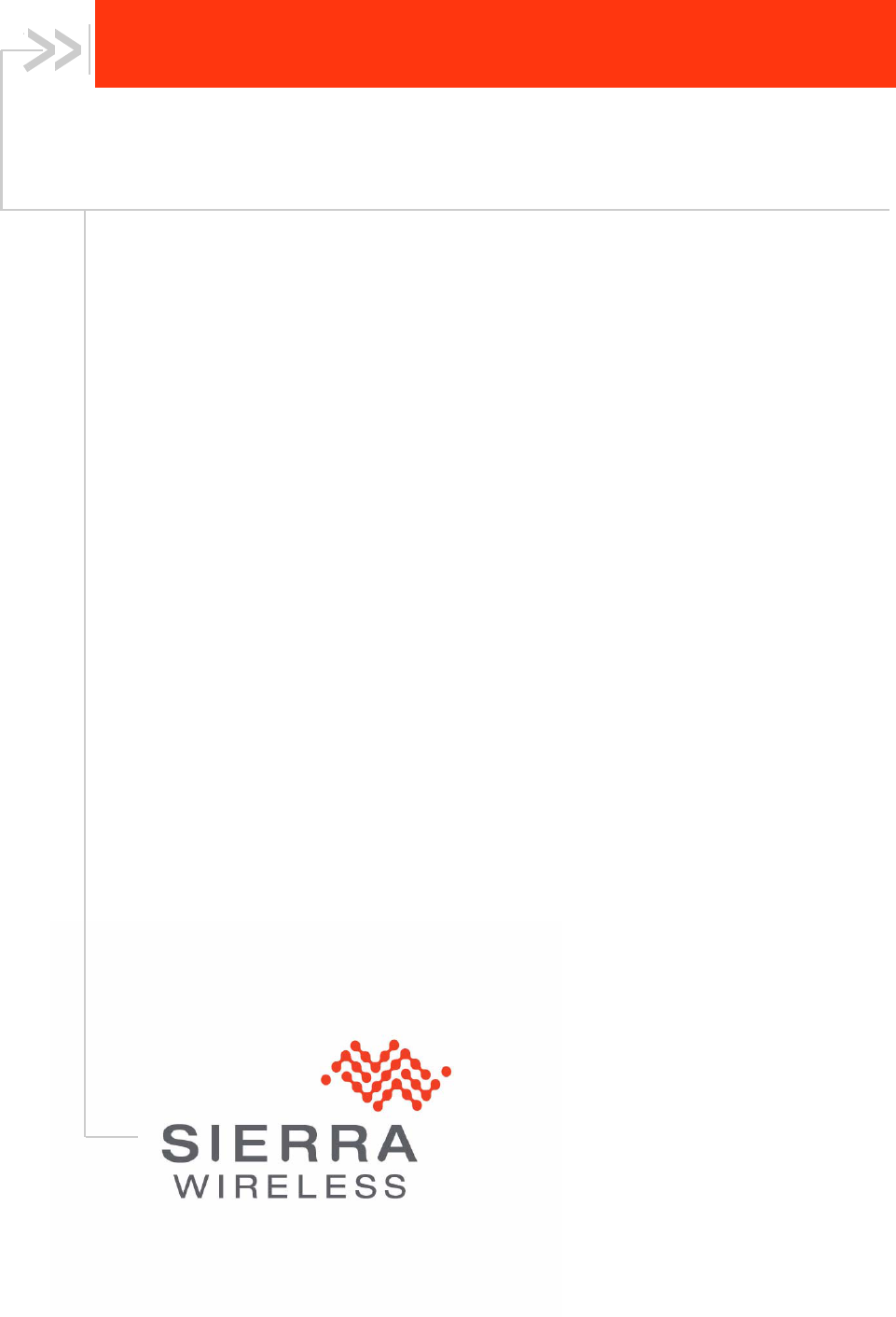
AirPrime MC7700
Hardware Integration Guide
2130114
Rev 4.0.1

Preface
Rev 4.0.1 May.11 Proprietary and Confidential 3
Important
Notice
Due to the nature of wireless communications, transmission and reception of data
can never be guaranteed. Data may be delayed, corrupted (i.e., have errors) or be
totally lost. Although significant delays or losses of data are rare when wireless
devices such as the Sierra Wireless modem are used in a normal manner with a
well-constructed network, the Sierra Wireless modem should not be used in
situations where failure to transmit or receive data could result in damage of any
kind to the user or any other party, including but not limited to personal injury,
death, or loss of property. Sierra Wireless accepts no responsibility for damages
of any kind resulting from delays or errors in data transmitted or received using
the Sierra Wireless modem, or for failure of the Sierra Wireless modem to
transmit or receive such data.
Safety and
Hazards
Do not operate the Sierra Wireless modem in areas where blasting is in progress,
where explosive atmospheres may be present, near medical equipment, near life
support equipment, or any equipment which may be susceptible to any form of
radio interference. In such areas, the Sierra Wireless modem MUST BE
POWERED OFF. The Sierra Wireless modem can transmit signals that could
interfere with this equipment.
Do not operate the Sierra Wireless modem in any aircraft, whether the aircraft is
on the ground or in flight. In aircraft, the Sierra Wireless modem MUST BE
POWERED OFF. When operating, the Sierra Wireless modem can transmit
signals that could interfere with various onboard systems.
Note: Some airlines may permit the use of cellular phones while the aircraft is on the
ground and the door is open. Sierra Wireless modems may be used at this time.
The driver or operator of any vehicle should not operate the Sierra Wireless
modem while in control of a vehicle. Doing so will detract from the driver or
operator's control and operation of that vehicle. In some states and provinces,
operating such communications devices while in control of a vehicle is an offence.
Limitation of
Liability
The information in this manual is subject to change without notice and does not
represent a commitment on the part of Sierra Wireless. SIERRA WIRELESS AND
ITS AFFILIATES SPECIFICALLY DISCLAIM LIABILITY FOR ANY AND ALL
DIRECT, INDIRECT, SPECIAL, GENERAL, INCIDENTAL, CONSEQUENTIAL,
PUNITIVE OR EXEMPLARY DAMAGES INCLUDING, BUT NOT LIMITED TO,
LOSS OF PROFITS OR REVENUE OR ANTICIPATED PROFITS OR REVENUE
ARISING OUT OF THE USE OR INABILITY TO USE ANY SIERRA WIRELESS
PRODUCT, EVEN IF SIERRA WIRELESS AND/OR ITS AFFILIATES HAS BEEN
ADVISED OF THE POSSIBILITY OF SUCH DAMAGES OR THEY ARE
FORESEEABLE OR FOR CLAIMS BY ANY THIRD PARTY.
Notwithstanding the foregoing, in no event shall Sierra Wireless and/or its
affiliates aggregate liability arising under or in connection with the Sierra Wireless
product, regardless of the number of events, occurrences, or claims giving rise to
liability, be in excess of the price paid by the purchaser for the Sierra Wireless
product.
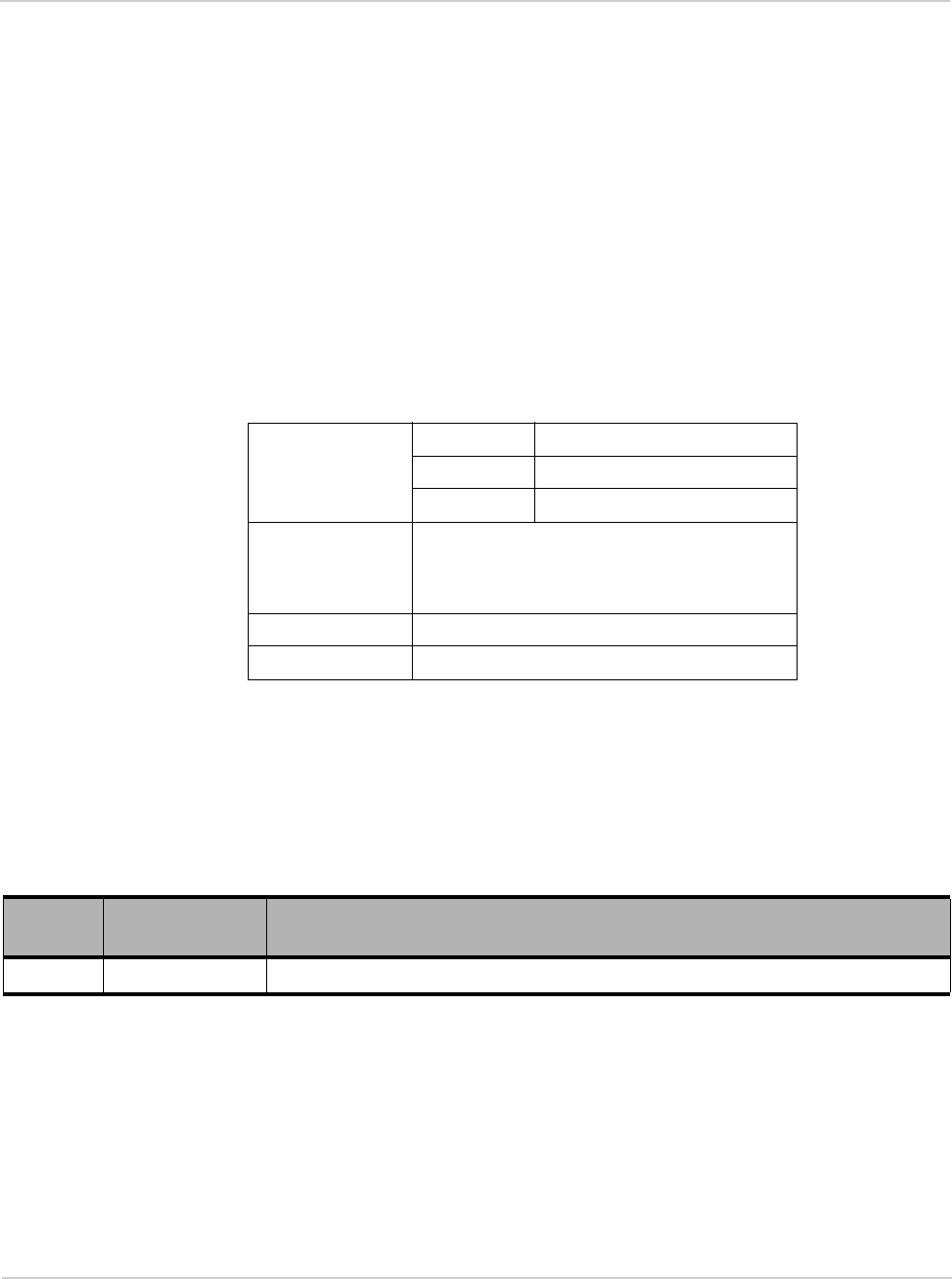
AirPrime MC7700 Hardware Integration Guide
4 Proprietary and Confidential 2130114
Patents This product may contain technology developed by or for Sierra Wireless Inc. This
product includes technology licensed from QUALCOMM® 3G. This product is
manufactured or sold by Sierra Wireless Inc. or its affiliates under one or more
patents licensed from InterDigital Group.
Copyright ©2011 Sierra Wireless. All rights reserved.
Trademarks Watcher® is a registered trademark of Sierra Wireless. Sierra Wireless™,
AirPrime™ and the Sierra Wireless logo are trademarks of Sierra Wireless.
Windows® is a registered trademark of Microsoft Corporation.
Other trademarks are the property of their respective owners.
Contact
Information
Consult our website for up-to-date product descriptions, documentation,
application notes, firmware upgrades, troubleshooting tips, and press releases:
www.sierrawireless.com
Revision
History
Sales Desk: Phone: 1-604-232-1488
Hours: 8:00 AM to 5:00 PM Pacific Time
E-mail: sales@sierrawireless.com
Post: Sierra Wireless
13811 Wireless Way
Richmond, BC
Canada V6V 3A4
Fax: 1-604-231-1109
Web: www.sierrawireless.com
Revision
number Release date Changes
4.0.1 May 2011 •FCC submission

Rev 4.0.1 May.11 Proprietary and Confidential 5
Contents
Introduction . . . . . . . . . . . . . . . . . . . . . . . . . . . . . . . . . . . . . . . . . . . . . . . . . . . . .7
The Universal Development Kit . . . . . . . . . . . . . . . . . . . . . . . . . . . . . . . . . . . 7
Required connectors . . . . . . . . . . . . . . . . . . . . . . . . . . . . . . . . . . . . . . . . . . . 7
Power Interface . . . . . . . . . . . . . . . . . . . . . . . . . . . . . . . . . . . . . . . . . . . . . . . . . .9
Overview of operation . . . . . . . . . . . . . . . . . . . . . . . . . . . . . . . . . . . . . . . . . . 9
Power signals . . . . . . . . . . . . . . . . . . . . . . . . . . . . . . . . . . . . . . . . . . . . . . .9
Electrostatic discharge (ESD) . . . . . . . . . . . . . . . . . . . . . . . . . . . . . . . . . .9
Module power states . . . . . . . . . . . . . . . . . . . . . . . . . . . . . . . . . . . . . . . . . . 10
RF Integration . . . . . . . . . . . . . . . . . . . . . . . . . . . . . . . . . . . . . . . . . . . . . . . . . .11
RF connection . . . . . . . . . . . . . . . . . . . . . . . . . . . . . . . . . . . . . . . . . . . . . . . 12
Ground connection. . . . . . . . . . . . . . . . . . . . . . . . . . . . . . . . . . . . . . . . . . . . 12
Shielding . . . . . . . . . . . . . . . . . . . . . . . . . . . . . . . . . . . . . . . . . . . . . . . . .12
Antenna and cabling . . . . . . . . . . . . . . . . . . . . . . . . . . . . . . . . . . . . . . . .12
Interference and sensitivity. . . . . . . . . . . . . . . . . . . . . . . . . . . . . . . . . . . . . . 13
Power supply noise . . . . . . . . . . . . . . . . . . . . . . . . . . . . . . . . . . . . . . . . .13
Interference from other wireless devices . . . . . . . . . . . . . . . . . . . . . . . . .13
Host-generated RF interference . . . . . . . . . . . . . . . . . . . . . . . . . . . . . . .14
Device-generated RF interference . . . . . . . . . . . . . . . . . . . . . . . . . . . . . .14
Regulatory Information . . . . . . . . . . . . . . . . . . . . . . . . . . . . . . . . . . . . . . . . . . 15
Important notice . . . . . . . . . . . . . . . . . . . . . . . . . . . . . . . . . . . . . . . . . . . . . . 15
Safety and hazards . . . . . . . . . . . . . . . . . . . . . . . . . . . . . . . . . . . . . . . . . . . 15
Important compliance information for North American users . . . . . . . . . . . . 16
Acronyms and Definitions . . . . . . . . . . . . . . . . . . . . . . . . . . . . . . . . . . . . . . . 17
Index . . . . . . . . . . . . . . . . . . . . . . . . . . . . . . . . . . . . . . . . . . . . . . . . . . . . . . . . . 19

AirPrime MC7700 Hardware Integration Guide
6 Proprietary and Confidential 2130114

Rev 4.0.1 May.11 Proprietary and Confidential 7
1
1: Introduction
Sierra Wireless’ AirPrime Intelligent Embedded Modules form the
radio component for the products in which they are embedded.
The AirPrime MC7700 is available for use on LTE, WCDMA and GSM
networks.
Note: An understanding of
network technology, and
experience in integrating
hardware components into
electronic equipment is
assumed.
Purpose of this guide
This guide addresses issues that affect the integration of AirPrime
embedded modules into host products, and includes design
recommendations for the host products.
The Universal Development Kit
Sierra Wireless manufactures a Universal Development Kit (UDK)
that facilitates all phases of the integration process.
This kit is a hardware development platform that is designed to
support the AirPrime embedded modules. It contains the hardware
components that are typically necessary for evaluating and
developing with the module, including:
•Development board
•Cables
•Antennas
•Other accessories
For instructions on setting up the UDK, see PCI Express Mini Card
Dev Kit Quick Start Guide (Document 2130705).
Required connectors
Note: Contact vendors
before choosing your
connectors—the numbers
included here are for
reference only. Choose
connectors that are appro-
priate to your design.
When integrating AirPrime embedded modules into your host device,
you need the following connector types:
•RF cables that mate with Hirose U.FL connectors (model
U.FL #CL331-0471-0-10). Modules include two or three
connector jacks depending on module support for diversity and
GPS functionality.
•Industry-standard mating connector for 52-pin EDGE—some
manufacturers include Tyco, Foxconn, and Molex. For example,
the connector used on the Mini Card Dev Kit board is a Molex
67910-0001.
•Industry-standard USIM connector—the actual connector you
use depends on how your device exposes the USIM socket. For
example, the USIM connector used on the Mini Card Dev Kit
board is an ITT CCM03-3518.

AirPrime MC7700 Hardware Integration Guide
8 Proprietary and Confidential 2130114

Rev 4.0.1 May.11 Proprietary and Confidential 9
2
2: Power Interface
Overview of operation
AirPrime embedded modules are designed to use a 3.3V (nominal)
power supply provided by the host. It is the host’s responsibility to
provide safe and continuous power to the module at all times; the
module does NOT have an independent power supply, or protection
circuits to guard against electrical issues.
The module’s power state is controlled by the host’s assertion/
deassertion of W_Disable#. The module also monitors its supply
voltage and requests shutdown if the supply is insufficient.
Power signals
The module must be connected to a 3.3V power supply, as described
in PCI Express Mini Card Electromechanical Specification Revision
1.1.
For detailed pinout and voltage/current requirements of these
modules, see the Product Technical Specification Document for your
AirPrime embedded module.
Electrostatic discharge (ESD)
You are responsible for ensuring that the host has adequate ESD
protection on digital circuits and antenna ports as described by the
following specifications:
•(Operational) RF port (antenna launch and RF connector): IEC-
61000-4-2—Level (Electrostatic Discharge Immunity Test)
•(Non-operational) Host connector interface: JESD22-A114-B +/-
1kV Human Body Model and JESD22-C101 +/- 125 V Charged
Device Model
This guide provides specific recommendations where needed,
however, the level of protection required depends on your application.
Note: ESD protection is highly recommended for the USIM connector at the
point where the contacts are exposed, and for any other signals from the host
interface that would be subjected to ESD by the user of the product.
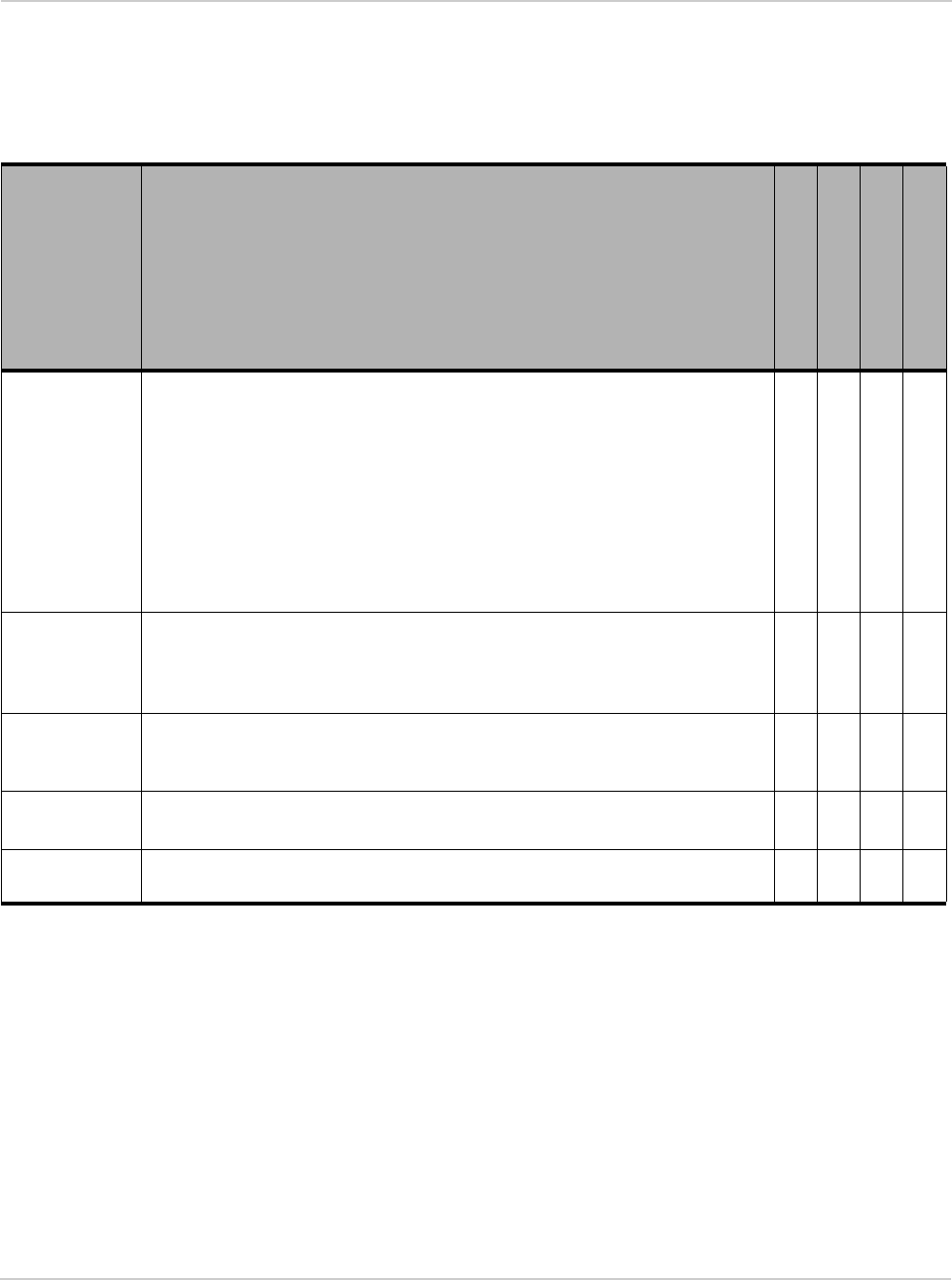
AirPrime MC7700 Hardware Integration Guide
10 Proprietary and Confidential 2130114
Module power states
The module has five power states, as described in Ta b l e 2 - 1 .
Table 2-1: Module power states
State Details
Host is powered
Module is powered
USB interface active
RF enabled
Normal
(Default
state)
•Module is active
•Default state when VCC is first applied in the absence of W_DISABLE_N control
•Module is capable of placing/receiving calls, or establishing data connections on the
wireless network
•Current consumption is affected by several factors, including:
•Radio band being used
•Transmit power
•Receive gain settings
•Data rate
•Number of active Tx time slots
Low power
(‘Airplane
mode’)
•Module is active
•State is controlled by host interface using software commands:
•+CFUN=0 (AT Command Set for User Equipment (UE) (Release 6) (Doc# 3GPP
TS 27.007)))
Sleep •Normal state of module between calls or data connections
•Module cycles between wake (polling the network) and sleep, at network provider-
determined interval.
Off •Host keeps module powered off by driving W_DISABLE_N low
•Module draws minimal current
Disconnected •Host power source is disconnected from the module and all voltages associated with
the module are at 0 V.
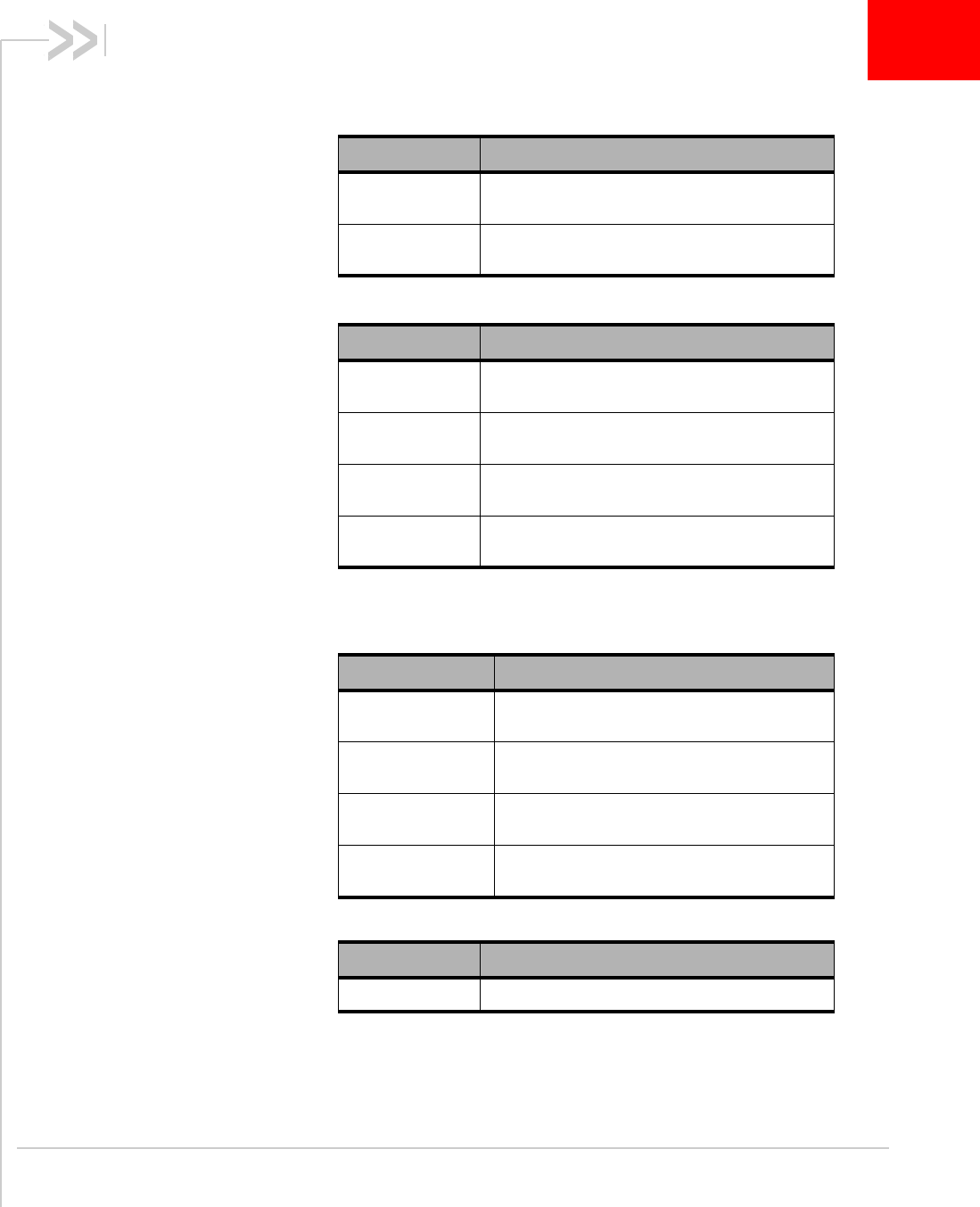
Rev 4.0.1 May.11 Proprietary and Confidential 11
3
3: RF Integration
The AirPrime MC7700 operates on the frequency bands listed below.
Table 3-1: LTE frequency band support
Band Frequencies
Band 4 (AWS) Tx: 1710–1755 MHz
Rx: 2110–2155 MHz
Band 17 Tx: 704–716 MHz
Rx: 734–746 MHz
Table 3-2: WCDMA frequency band supporta
a. WCDMA channel spacing is 5 MHz, but this can be adjusted to
optimize performance in a particular deployment scenario.
Band Frequencies
Band 1
WCDMA 2100 Tx: 1920–1980 MHz
Rx: 2110–2170 MHz
Band 2
WCDMA 1900 Tx: 1850–1910 MHz
Rx: 1930–1990 MHz
Band 5
WCDMA 850 Tx: 824–849 MHz
Rx: 869–894 MHz
Band 6
WCDMA 800 Tx: 830–840 MHz
Rx: 875–885 MHz
Table 3-3: GSM frequency band support
Band Frequencies
GSM 850 Tx: 824–849 MHz
Rx: 869–894 MHz
EGSM 900 Tx: 880–915 MHz
Rx: 925–960 MHz
GSM 1800 Tx: 1710–1785 MHz
Rx: 1805–1880 MHz
GSM 1900 Tx: 1850–1910 MHz
Rx: 1930–1990 MHz
Table 3-4: GPS frequency band support
Band Frequencies
GPS 1575.42 MHz

AirPrime MC7700 Hardware Integration Guide
12 Proprietary and Confidential 2130114
RF connection
When attaching an antenna to the module:
Note: To disconnect the
antenna, make sure you
use the Hirose U.FL
connector removal tool
(P/N UFL-LP-N-2(01)) to
prevent damage to the
module or coaxial cable
assembly.
•Use a Hirose U.FL connector (model U.FL #CL331-0471-0-10) to attach an
antenna to a connection point on the module.
•Match coaxial connections between the module and the antenna to 50
•Minimize RF cable losses to the antenna; the recommended maximum cable
loss for antenna cabling is 0.5 dB.
•To ensure best thermal performance, if possible use the mounting holes to
attach (ground) the device to the main PCB ground or a metal chassis.
Note: If the antenna connection is shorted or open, the modem will not sustain permanent
damage.
Ground connection
When connecting the module to system ground:
•Prevent noise leakage by establishing a very good ground connection to the
module through the host connector.
•Connect to system ground using the two mounting holes at the top of the
module.
•Minimize ground noise leakage into the RF.
Depending on the host board design, noise could potentially be coupled to
the module from the host board. This is mainly an issue for host designs that
have signals traveling along the length of the module, or circuitry operating at
both ends of the module interconnects.
Shielding
The module is fully shielded to protect against EMI and must not be removed.
Antenna and cabling
When selecting the antenna and cable, it is critical to RF performance to match
antenna gain and cable loss.
Choosing the correct antenna and cabling
Consider the following points for proper matching of antennas and cabling:
•The antenna (and associated circuitry) should have a nominal impedance of
50 with a return loss of better than 10 dB across each frequency band of
operation.
•The system gain value affects both radiated power and regulatory (FCC, IC,
CE, etc.) test results.

RF Integration
Rev 4.0.1 May.11 Proprietary and Confidential 13
Developing custom antennas
Consider the following points when developing custom-designed antennas:
•A skilled RF engineer should do the development to ensure that the RF
performance is maintained.
•Identify the bands that need to be supported
Determining the antenna’s location
Consider the following points when deciding where to put the antenna:
•Antenna location may affect RF performance. Although the module is
shielded to prevent interference in most applications, the placement of the
antenna is still very important—if the host device is insufficiently shielded,
high levels of broadband or spurious noise can degrade the module’s perfor-
mance.
•Connecting cables between the module and the antenna must have 50
impedance. If the impedance of the module is mismatched, RF performance
is reduced significantly.
•Antenna cables should be routed, if possible, away from noise sources
(switching power supplies, LCD assemblies, etc.). If the cables are near the
noise sources, the noise may be coupled into the RF cable and into the
antenna.
Interference and sensitivity
Note: The MC7700 is
based on ZIF (Zero Inter-
mediate Frequency)
technologies. When
performing EMC (Electro-
magnetic Compatibility)
tests, there are no IF
(Intermediate Frequency)
components from the
module to consider.
Several sources of interference can affect the RF performance of the module
(RF desense). Common sources include power supply noise and device-
generated RF.
RF desense can be addressed through a combination of mitigation techniques
and radiated sensitivity measurement.
Power supply noise
Noise in the power supply can lead to noise in the RF signal.
The power supply ripple limit for the module is no more than 200 mVp-p 1 Hz to
100 kHz. This limit includes voltage ripple due to transmitter burst activity.
Interference from other wireless devices
Wireless devices operating inside the host device can cause interference that
affects the module.
To determine the most suitable locations for antennas on your host device,
evaluate each wireless device’s radio system, considering the following:
•Any harmonics, sub-harmonics, or cross-products of signals generated by
wireless devices that fall in the module’s Rx range may cause spurious
response, resulting in decreased Rx performance.

AirPrime MC7700 Hardware Integration Guide
14 Proprietary and Confidential 2130114
•The Tx power and corresponding broadband noise of other wireless devices
may overload or increase the noise floor of the module’s receiver, resulting in
Rx desense.
The severity of this interference depends on the closeness of the other antennas
to the module’s antenna. To determine suitable locations for each wireless
device’s antenna, thoroughly evaluate your host device’s design.
Host-generated RF interference
All electronic computing devices generate RF interference that can negatively
affect the receive sensitivity of the module.
Proximity of host electronics to the antenna in wireless devices can contribute to
decreased Rx performance. Components that are most likely to cause this
include:
•Microprocessor and memory
•Display panel and display drivers
•Switching-mode power supplies
Device-generated RF interference
The module can cause interference with other devices. Wireless devices such as
AirPrime embedded modules transmit in bursts (pulse transients) for set durations
(RF burst frequencies). Hearing aids and speakers convert these burst
frequencies into audible frequencies, resulting in audible noise.

Rev 4.0.1 May.11 Proprietary and Confidential 15
A
A: Regulatory Information
Important notice
Because of the nature of wireless communications, transmission and
reception of data can never be guaranteed. Data may be delayed,
corrupted (i.e., have errors) or be totally lost. Although significant
delays or losses of data are rare when wireless devices such as the
Sierra Wireless modem are used in a normal manner with a well-
constructed network, the Sierra Wireless modem should not be used
in situations where failure to transmit or receive data could result in
damage of any kind to the user or any other party, including but not
limited to personal injury, death, or loss of property. Sierra Wireless
and its affiliates accept no responsibility for damages of any kind
resulting from delays or errors in data transmitted or received using
the Sierra Wireless modem, or for failure of the Sierra Wireless
modem to transmit or receive such data.
Safety and hazards
Do not operate your MC7700 modem:
•In areas where blasting is in progress
•Where explosive atmospheres may be present including
refuelling points, fuel depots, and chemical plants
•Near medical equipment, life support equipment, or any
equipment which may be susceptible to any form of radio inter-
ference. In such areas, the MC7700 modem MUST BE
POWERED OFF. Otherwise, the MC7700 modem can transmit
signals that could interfere with this equipment.
In an aircraft, the MC7700 modem MUST BE POWERED OFF.
Otherwise, the MC7700 modem can transmit signals that could
interfere with various onboard systems and may be dangerous to the
operation of the aircraft or disrupt the cellular network. Use of a
cellular phone in an aircraft is illegal in some jurisdictions. Failure to
observe this instruction may lead to suspension or denial of cellular
telephone services to the offender, or legal action or both.
Some airlines may permit the use of cellular phones while the aircraft
is on the ground and the door is open. The MC7700 modem may be
used normally at this time.

AirPrime MC7700 Hardware Integration Guide
16 Proprietary and Confidential 2130114
Important compliance information for
North American users
The MC7700 modem has been granted modular approval for mobile applications.
Integrators may use the MC7700 modem in their final products without additional
FCC/IC (Industry Canada) certification if they meet the following conditions.
Otherwise, additional FCC/IC approvals must be obtained.
1. At least 20 cm separation distance between the antenna and the user’s body
must be maintained at all times.
2. To comply with FCC / IC regulations limiting both maximum RF output power
and human exposure to RF radiation, the maximum antenna gain including
cable loss in a mobile-only exposure condition must not exceed 7.5 dBi in the
Cellular band, 3 dBi in the PCS band, 5.5 dBi in LTE Band4, and 9 dBi in LTE
Band 17.
3. The MC7700 modem and its antenna must not be co-located or operating in
conjunction with any other transmitter or antenna within a host device.
4. A label must be affixed to the outside of the end product into which the
MC7700 modem is incorporated, with a statement similar to the following:
· This device contains FCC ID: N7NMC7700
Contains transmitter module IC: 2417C-MC7700 where 2417C-MC7700
is the module’s certification number.
5. A user manual with the end product must clearly indicate the operating
requirements and conditions that must be observed to ensure compliance
with current FCC / IC RF exposure guidelines.
The end product with an embedded MC7700 modem may also need to pass the
FCC Part 15 unintentional emission testing requirements and be properly
authorized per FCC Part 15.
Note: If this module is intended for use in a portable device, you are responsible
for separate approval to satisfy the SAR requirements of FCC Part 2.1093 and IC
RSS-102.
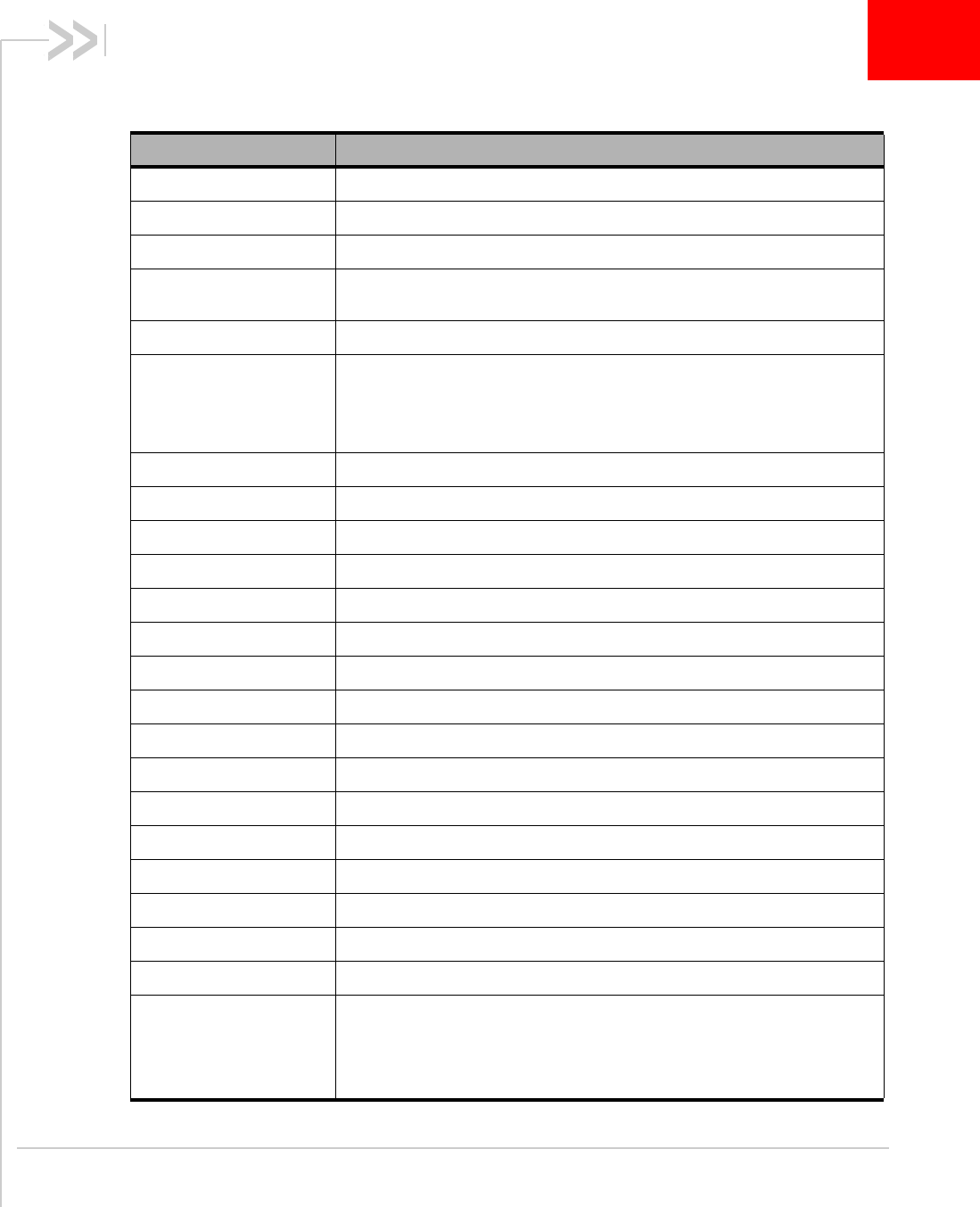
Rev 4.0.1 May.11 Proprietary and Confidential 17
B
B: Acronyms and Definitions
.
Table B-1: Acronyms and definitions
Acronym or term Definition
AGC Automatic Gain Control
BER Bit Error Rate - a measure of receive sensitivity
BLER Block Error Rate
Call Box Base Station Simulator - Agilent E8285A or 8960, Rohde & Schwarz
CMU200
CDMA Code Division Multiple Access
dB Decibel = 10 x log10 (P1/P2)
P1 is calculated power; P2 is reference power
Decibel = 20 x log10 (V1/V2)
V1 is calculated voltage, V2 is reference voltage
dBm Decibels, relative to 1 mW - Decibel(mW) = 10 x log10 (Pwr (mW)/1mW)
DUT Device Under Test
EDGE Enhanced Data rates for GSM Evolution
EM Embedded Module
ESD ElectroStatic Discharge
FER Frame Error Rate - a measure of receive sensitivity
GPRS General Packet Radio Services
GPS Global Positioning System
GSM Global System for Mobile communications
Hz Hertz = 1 cycle/second
inrush current Peak current drawn when a device is connected or powered on
IS-2000 3G radio standards for voice and data (CDMA only)
IS-95 2G radio standards targeted for voice (cdmaONE)
LDO Low Drop Out - refers to linear regulator
MC5728V Sierra Wireless AirPrime embedded modules used on CDMA networks
MC57xx Any of the following CDMA AirPrime embedded modules: MC5728V
MC8700/MC8704/
MC8705/MC8790/
MC8790V/MC8791V/
MC8792V/MC8795V/
MC8801
Sierra Wireless AirPrime embedded modules used on GSM/UMTS
networks

AirPrime MC7700 Hardware Integration Guide
18 Proprietary and Confidential 2130114
MC8xxx Any of the following GSM/UMTS AirPrime embedded modules: MC8700/
MC8704/MC8705/MC8790/MC8790V/MC8791V/MC8792V/MC8795V/
MC8801
MHz MegaHertz = 10E6 Hertz (Hertz = 1 cycle/second)
MIO Module Input/Output
MPE Maximum Permissible Exposure—the level of radiation to which a person
may be exposed without hazardous effect or adverse biological changes
OTA Over-The-Air or Radiated through the antenna
PCS Personal Communication System - PCS spans the 1.9 GHz radio spectrum
RF Radio Frequency
RMS Root Mean Square
SA Selective Availability
Sensitivity (Audio) Measure of lowest power signal that the receiver can measure
Sensitivity (RF) Measure of lowest power signal at the receiver input that can provide a
prescribed BER/BLER/SNR value at the receiver output.
SIM Subscriber Identity Module
SNR Signal to Noise Ratio
SOF Start of Frame - a USB function
UART Universal Asynchronous Receiver Transmitter
UDK Universal Development Kit (PCI Express Mini Card Dev Kit)
UMTS Universal Mobile Telecommunications System
USB Universal Serial Bus
USIM Universal Subscriber Identity Module
VCC Supply voltage (3.3 V for these devices)
WCDMA Wideband Code Division Multiple Access—In this document, the term
“UMTS” is used instead of “WCDMA”.
XIM In this document, XIM is used as part of the contact identifiers for the USIM
interface (XIM_VCC, XIM_CLK, etc.).
Table B-1: Acronyms and definitions
Acronym or term Definition

Rev 4.0.1 May.11 Proprietary and Confidential 19
A
acronyms and definitions, 17– 18
antenna
connection considerations, 12
custom, considerations, 13
limit, matching coaxial connections, 12
location, considerations, 13
matching, considerations, 12
maximum cable loss, 12
B
bands supported, RF
GSM, 11
LTE, 11
WCDMA, 11
C
cable loss
antenna, maximum, 12
connection
grounding, 12
connectors, required
EDGE mating (52-pin), 7
host-module, 7
RF, Hirose, 7
USIM, 7
D
desense. See RF
E
EDGE connector, manufacturers, 7
electrostatic discharge. See ESD
ESD
protection requirements, 9
F
frequency band support
GPS, 11
GSM, 11
LTE, 11
WCDMA, 11
G
gain
maximum, 16
GPS
frequency band support, 11
grounding
connection considerations, 12
GSM
frequency band support, 11
I
impedance
module-antenna, 13
interference
device generated, 14
host-generated, 14
power supply noise, 13
wireless devices, 13
L
LTE
frequency band support, 11
M
module
power states, 10
N
noise
leakage, minimizing, 12
RF interference, power supply, 13
P
power
required supply voltage, 9
signals, overview, 9
states, module, 10
supply, RF interference, 13
supply, ripple limit, 13
power interface, 9– 10
R
regulatory information, 15– 16
FCC, 16
limitation of liability, 15
safety and hazards, 15
Index

Document SubTitle
20 Proprietary and Confidential 2130114
RF
antenna cable loss, maximum, 12
antenna connection, considerations, 12
cable type, required, 7
desense
device-generated, 14
integration, 11– 14
interference
other devices, 14
power supply, 13
wireless devices, 13
RF bands supported
GSM, 11
LTE, 11
WCDMA, 11
S
shielding
module, compliance, 12
SIM
See also USIM
U
UDK (Universal Development Kit)
components, included, 7
Universal Development Kit (UDK)
components, included, 7
USIM
connector type, required, 7
W
WCDMA
frequency band support, 11
Z
ZIF (Zero Intermediate Frequency), 13
